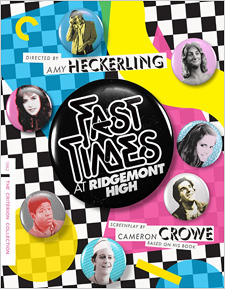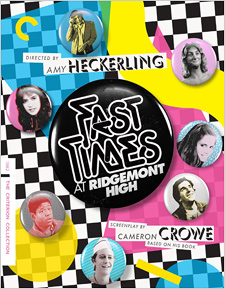Fast Times at Ridgemont High (Blu-ray Review)

Director
Amy HeckerlingRelease Date(s)
1982 (May 11, 2021)Studio(s)
Universal Pictures (Criterion – Spine #1075)- Film/Program Grade: B
- Video Grade: A
- Audio Grade: A
- Extras Grade: A-
Review
Writer Cameron Crowe went back to high school undercover at age 22 to do research on what a new generation was doing and thinking. Enrolling as a senior, he passed the age test, wrote a novel based upon his observations, and adapted it into the screenplay for Fast Times at Ridgemont High. First-time director Amy Heckerling assembled a cast of young actors in a film that attempts to capture the foibles and mores of suburban teenagers in the early 1980s.
Stacy (Jennifer Jason Leigh) and best friend Linda (Phoebe Cates) work in a mall pizzeria. Stacy’s brother Brad (Judge Reinhold) is a dedicated fast food worker. Mark (young Woody Allen lookalike Brian Backer) is a ticket taker at a movie theater. Mike (Robert Romanus) scalps concert tickets. Charles Jefferson (Forest Whitaker) is the school’s star football player. Unlike his fellow students, Jeff Spicoli (Sean Penn) isn’t burdened by these responsibilities. A carefree slacker marching to his own beat, he’s a dude who imagines a future as a surfing champ with women flocking to him. Meawhile, he disrupts history class and annoys its strict teacher, Mr. Hand (Ray Walston). Fast Times at Ridgemont High follows these students over the course of a year.
There’s no single through line for the film, but episodes showing various characters being themselves instead. Stacy and Linda converse graphically about boys and how to please them (yet what was once controversial has since lost its shock value). Brad, likable but not overly ambitious, bounces from one job to the next, always managing to prove himself a reliable, eager employee. Mark awkwardly tries to make Stacy notice him, taking tips from Mike, who willingly shares what he believes are helpful pointers. And Spicoli drives Mr. Hand crazy, arriving late, failing to take lessons seriously, and even having a pizza delivered to himself during class. His character is the most memorable, providing most of the film’s comedy.
And though it is a comedy, Fast Times addresses serious issues, including casual sex, teen pregnancy, abortion, and betrayal. Stacy’s first two sexual encounters are not the idyllic moments she imagined and are hardly romanticized. Some scenes work better than others and the film lacks consistency. Heckerling enhances scenes with songs by Jackson Browne, Don Henley, Oingo Boingo, Stevie Nicks, Graham Nash, Sammy Hagar, The Go-Go’s, The Cars, Tom Petty and other musical artists of the time—the perfect soundtrack for a film about teenagers in the 1980s.
The young cast is supposed to be between the ages of 15 and 18, yet only Phoebe Cates and Jennifer Jason Leigh fall into that category. The rest are older, and most of them look it. Many would go on to successful careers. For others, Fast Times would be their high point. Romanus as the cool dude who covers his insecurities with swagger and Backer as the shy nerd are convincing, but neither of them gathered enough steam from their roles to propel their careers. Penn, of course, became a star and has shown tremendous versatility in subsequent roles. Cates, Leigh, Reinhold, Whitaker, Eric Stoltz, Anthony Edwards, and Nicolas Cage (billed as Nicolas Coppola) would all enjoy fruitful careers.
Featuring 1080p resolution, the new Blu-ray from the Criterion Collection is presented in the widescreen aspect ratio of 1.85:1. This version of the film, which was supervised by director Amy Heckerling, not only restores a censored shot of male nudity that was originally cut to avoid an X-rating, but slightly reframes it and alters the color timing for a cooler palette. The differences are minor, but avid, long-time viewers might notice. Content-wise, the film is otherwise the same as before. According to the enclosed booklet, “this new digital transfer was created in 16-bit 4K resolution on a Lasergraphics Director film scanner from the 35-millimeter original camera negative.” Dirt, debris, scratches, splices, and warps were manually removed, and jitter and flicker were corrected. Clarity and color saturation are excellent, with neon lights, video consoles, and store signs underscoring the mall’s role as a social activity center. Flesh tones are natural, with the young women’s complexions particularly creamy smooth. Linda’s famous red bikini, Brad’s baby blue Buick Le Sabre, and the red uniforms of the cheerleaders really pop.
The soundtrack is presented in English 5.1 DTS-High Definition Master Audio (replacing the original mono soundtrack, which has purportedly been lost). Optional subtitles in English SDH are also available. Dialogue is clear and crisp throughout, never overpowered by crowd noise or music. Penn adopts a laid-back surfer dude manner of speaking which he sustains throughout. This contrasts with Walston’s clipped, formal manner. The soundtrack is at its most exciting when music is played as background or in transitional scenes, giving the film considerable energy. Sound effects enhance a scene in which Spicoli wrecks the football player’s car. This version also restores a previously missing sound effect, which was evident on Universal’s Blu-ray release of the film at around the 00:08:18 mark. Overall, the soundtrack is clean with excellent fidelity and range.
Bonus materials on the R-rated Blu-ray release include a new introduction by screenwriter Cameron Crowe; audio commentary featuring director Amy Heckerling and Crowe; the TV version of the film; a new conversation with Heckerling and Crowe; a 1999 documentary featuring interviews with the cast and crew; a 1982 audio discussion with Heckerling at the American Film Institute; and a booklet containing a critical essay.
Audio Commentary – This 1999 commentary features director Amy Heckerling and screenwriter Cameron Crowe discussing the film’s pre-production, casting mostly unknown actors (many of whom would go on to successful careers), adapting the film from Crowe’s novel, selecting music for the soundtrack, and their compatible working relationship. They also discuss the studio exercising its power to remove a particular shot that the executives believed would have earned the film an X-rating and unfavorable test screenings (as previously mentioned, restored for this release).
Reliving Our Fast Times at Ridgemont High – Amy Heckerling, producer Art Linson, casting director Don Phillips, and many of the actors offer insights about the making of the film in this 1999 documentary. Crowe was a teenager working as a journalist. He is incisive as to how he gets inside people and has a keen ear and sense of what characters are about. Casting director Phillips loved young actors and knew the plan was to find unknowns who could not overstretch the small budget. Casting Spicoli was paramount. Sean Penn, who had done theater and a few films, was clear-headed about his performance. Watching Penn transform into Spicoli was like seeing a “magic trick.” Ray Walston says Penn was so deep into his character that “for three or four days, I was afraid of him.” The film was “everybody’s first big project.” Before it was released, the studio hated it and pulled it from East Coast theaters so as to not waste money on publicity. Great material draws out great actors, and there was a lot of interest in the film by young actors. Heckerling, who identifies most with the Mark Ratner character, notes the significance of the film’s title: times are too fast for kids with so many pressures on them. Walston notes, “Being part of a film that’s become a cult classic is a great feeling.”
New Conversation with Amy Heckerling and Cameron Crowe – Hosted by Olivia Wilde. Crowe, a journalist for Rolling Stone, had written an article called How I Learned About Sex, which opened a door to writing more personally. He went back to school anonymously so that he could watch, talk to, and understand high school kids of the early 80s. He wanted to tell a story from their point of view. Heckerling found the book “unbelievably realistic” and wanted to give dignity to all of the characters. By moving most of the action to the mall, she captured the early days of “mall culture.” The film “just slid under a closing door” regarding sex and drugs on screen. Leigh was uninhibited in embracing the material. Heckerling was considering Scott Baio and Ralph Macchio, but they had both become too big and would have thrown off the casting balance. Sean Penn stayed in character during the entire film. Ray Walston scared Heckerling. “He was strict, which was perfect for the character.” Music allows the audience to re-experience the emotional journey of the film. “The movie taps into the humanity of all the things that people tend to be ashamed of.”
Audio Discussion with Amy Heckerling – Heckerling was interviewed at the AFI (American Film Institute) on November 19, 1982 after a screening of the film. She discusses the long, circuitous journey of getting Fast Times to the screen. She answers questions from the audience about controversial scenes, rehearsal time, unforeseen problems, studio involvement, and acquiring the music rights for songs used in the film. She notes that casting was done in Los Angeles and New York and expresses how difficult it is for a first-time director to be hired for a studio feature film.
TV Version – This version of the film is presented in 1080p with an English 1.0 Dolby Digital soundtrack. Because of the language, sex, and nudity, major edits had to be made for the network broadcast of the film. This reduced the running time, so unused footage was inserted to bring it up to 95 minutes—5 minutes longer than the theatrical version which, with commercials, would comfortably fit into a 2-hour time slot. Nicolas Cage appears in a few scenes, and an entire scene about Stacy’s abortion is restored. Swearing is dubbed, the dugout and pool scenes are eliminated, and a suggestive scene with carrots is gone. Linda’s pool fantasy scene is still in but an alternate non-topless shot is used instead.
Booklet – The 20-page insert booklet contains an introduction by Cameron Crowe, a critical essay by Dana Stevens, cast and key crew list, several color and black-and-white photos, and information about the digital transfer.
Not included from the film's DVD releases are the Hangouts of Ridgemont High location featurettes, the Music Highlights film clips, the production notes, and the film's trailer. From Universal’s previous Blu-ray, you also lose the Scene Companion and The Music of Fast Times at Ridgemont High U-Control options.
Fast Times at Ridgemont High cleverly blends comedy and drama. The film’s uninhibited approach to teen sexuality is not merely an excuse for frat boy jokes, but an unblinking look at what many young people deal with. The middle-class teens in the film are leading adult lives even though they’re not prepared for it, and times are moving faster than they can reasonably manage.
- Dennis Seuling

